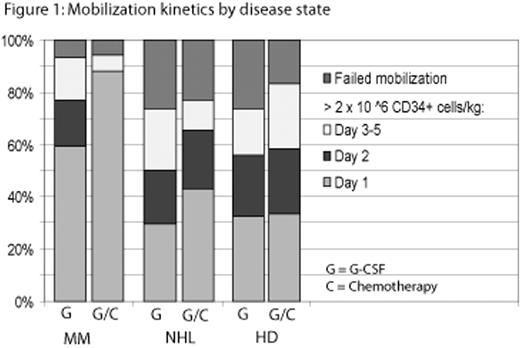Abstract
Background: No standard approach for the mobilization of peripheral hematologic stem and progenitor cells (HSPCs) has been established. High levels of circulating CD34+ cells, a surrogate marker for mobilization efficiency, are associated with less apheresis days. A higher dose of CD34+ cell transfused after high-dose chemotherapy decreases time to hematologic recovery. Consequently, a better understanding of variables associated with mobilization kinetics may further optimize stem cell collection and reduce complications associated with autologous stem cell transplants.
Methods: The Washington University (St. Louis, MO) transplantation database includes clinical parameters from 407 multiple myeloma (MM), 567 non-Hodgkin’s Lymphoma (NHL), and 164 Hodgkin’s disease (HD) pts who received an ASCT between 1995 and 2006. A retrospective analysis of this large pt population was conducted to determine factors associated with the mobilization kinetics of CD34+ cells.
Results: Figure 1 summarizes the mobilization kinetics as defined by number of days to reach a target of 2 × 10^6 CD34+ cells/kg. Overall, the median number of aphereses to reach the target were 1, 2, and 2 in MM, NHL, and HD, respectively. Daily median CD34+ yields in MM pts were 3.8, 1.2, and 0.5 × 10^6 on day 1–3, respectively. In NHL pts, yields were 1.4, 0.8, and 0.4 × 10^6 on day 1–3. In HD pts, yields were 1.8, 0.8, and 0.3 × 10^6 on day 1–3, respectively. The addition of chemotherapy increased the % of pts requiring only a single apheresis to reach the mobilization target. Figure 2 summarizes the mobilization kinetics for each re-mobilization regimen. In general, a limited number of cells was collected with each aphereses; >70% of pts failed to mobilize 2 × 10^6 CD34+ cells/kg. In contrast, remobilization with AMD3100 allowed the collection of sufficient CD34+ cells in 67% of pts; median number of apheresis to reach the target was 3.
Conclusions: Factors associated with mobilization kinetics of CD34+ cells include disease state and mobilization regimen. Re-mobilization is associated with high failure rates, re-mobilization regimens including AMD3100 are more successful.
Disclosure: No relevant conflicts of interest to declare.
Author notes
Corresponding author



This feature is available to Subscribers Only
Sign In or Create an Account Close Modal